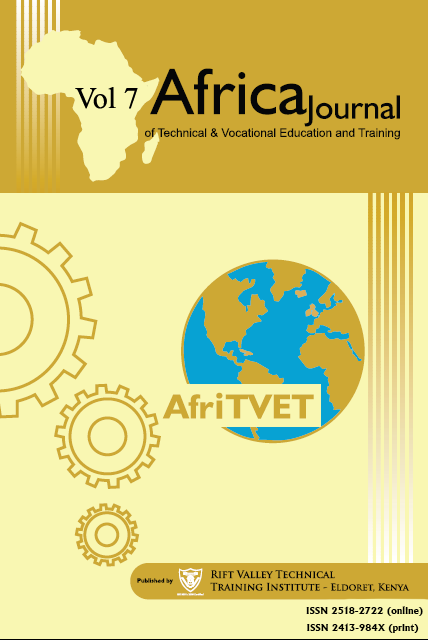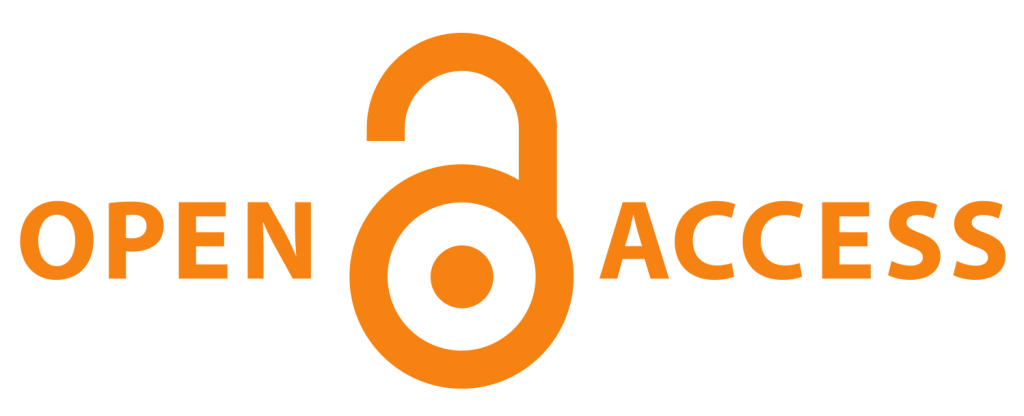The Effect of Blended Learning on the Academic Performance of Learners in National Examinations in TVET Institutions in Nairobi, Kenya
Abstract
Blended learning was implemented for the first time in TVET institutions in Kenya in 2020 following the closure of all learning institutions due to the Covid-19 pandemic. TVET institutions had traditionally trained learners using face to face approach. The transition from face to face learning to blended learning approach in TVET institutions in Kenya took learners and trainers by surprise. The study sought to establish the effect of blended learning on the academic performance of learners in Kenya National Examination Council (KNEC) exams in TVET institutions in Nairobi, Kenya. The study adopted a descriptive research design. The target population was TVET Kenya. A table was used to collect secondary information on the academic performance of learners in KNEC exams in the TVET institutions in Nairobi, Kenya. Tables and graphs were used to represent the analyzed data. The study revealed that there was no significant decrease in the average academic performance of learners in KNEC exams in 2020 when blended learning was implemented in TVET institutions in Nairobi, Kenya. However, the percentage of learners who had course requirement not met significantly increased in 2020 compared to other years. The study concluded that even if the learners and trainers had challenges using the blended learning approach, they made rigorous efforts and had the right attitude which made the academic performance of learners in KNEC exams not to decline significantly in 2020. The study recommended that learners and trainers should be trained on blended learning approach for its effective utilization. In addition the government should support blended learning in TVET institutions in Kenya through funding. Further, policy makers should consider the characteristics of the learners and trainers so as to reduce the barriers to successful implementation of blended learning by applying different strategies to each category of adopters.
Article Views and Downloands Counter
References
ADB Brief, No. 168 March (2021). COVID-19 impact on technical and vocational education and training in Sri Lanka. http://dx.doi.org/10.22617/BRF210081-2
Areba, G. N. (2020). COVID-19 pandemic impact on Kenyan education sector: Learner challen- ges and mitigations Journal of Research Innovation and Implications in Education Vol.4 (2) pp 128-139
Brolpito, A., Lightfoot, M., Radišić J., & Šćepanović, D. (2016). Digital and online learning vocational education and training in Serbia. https://www.etf.europa.eu/sites/default/ files/m/DC024C02AA9B9384C12580280043A0B6_DOL%20in%20VET%20in%20Serbia.pdf
Cara, M., & Chatani, K. (2019). Distance and e-learning in TVET. ILO. https://en.unesco.org/sites/default/files/wcms_732618.pdf
VOCED Plus. (UD). Focus on COVID-19 and online learning in VET. https://www.voced.edu.au/focus-
Gannon, K. (2020). 4 Lessons from moving a face-to-face course online. In: The Chronicle of Higher Education, Special Issue “Moving Online Now”, 24-27.
Hondonga, J., Chinengundu, T., & Maphosa, P. K. (2021).Online teaching of TVET courses: An analysis of Botswana private tertiary education providers’ responsiveness to the COVID-19 pandemic learning disruptions. The On-lineJournal of Technical and Vocational Education and Training in Asia, Issue 16. pp 1-16. www.tvet-online.asia
Lalima, D. K.L. (2017). Blended learning: An innovative approach. Universal Journal of Educational Research 5(1) pp 129-136. https://files.eric.ed.gov/fulltext/EJ1124666.pdf
Medlin, B. D. (2001). The factors that may influence a faculty member's decision to adopt electronic technologies in instruction. (Doctoral dissertation, Virginia Polytechnic Institute and State University, 2001). ProQuest DigitalDissertations. (UMI No. AAT3095210).
Muia, R. (2011). Challenges of adoption of ICT in technical training institutions within Nairobi County. Munich, GRIN Verlag. https://www.grin.com/document/184127
Neal, T. (2011). Open and distance technical and vocational education and training (TVET): Poor relation or knight in shining armour? Paper presented at the 24th ICDE World Conference on Open and Distance Learning, Bali, Indonesia.
Raihan, A., & Han, S. L. (2013). Integrating web-based e-learning in TVET to enhance the literacy and socio-economic condition for sustainable development of Bangladesh. Journal of Education and Practice Vol.4(1) pp 1-12. https://core.ac.uk/download/pdf/234633859.pdf
Rogers, E. M. ( 2003) Diffusion of innovations (fifth edition). The Free Press. A Division of Simon & Schuster.
Sahin, I., (2006). Detailed review of Rogers’ diffusion of innovations theory and educational technology related studies based on Rogers’ Theory. The Turkish Online Journal of Educational Technology – TOJET volume 5(2) Article 3
UNESCO-UNEVOC. (2020). Future of TVET teaching: Trends mapping study, UNESCO- UNEVOC International Centre for Technical and Vocational Education and Training. https://unevoc.unesco.org/pub/trendsmapping_futureoftvetteaching.pdf
United Nations. (2020). Policy Brief: Education during COVID-19 and beyond. https://www.un.org/development/desa/dspd/wp-content/uploads/sites/22/2020/08/sg_policy_ brief_covid-19_and_education_august_2020.pdf
World Health Organisation, (WHO). (2020). Coronavirus disease (COVID-19) technical guidance: Surveillance and case definitions. www.who.int/emergencies/diseases/novel- coronavirus-2019/technical-guidance/surveillance-and-case-definitions (retrieved 31.12.2020).
Yates, A., Brindley-Richards, W., & Thistoll, T. (2018). Student engagement in distance-based vocational education. Journal of Open, Flexible, and Distance Learning. https://files.eric.ed.gov/fulltext/EJ1079824.pdf
Copyright (c) 2022 Africa Journal of Technical and Vocational Education and Training

This work is licensed under a Creative Commons Attribution-NonCommercial-ShareAlike 4.0 International License.
Copyright Notice Copyright of published articles is held by AfriTVET. No limitation will be placed on the personal freedom of authors to copy or to use in subsequent work, material contained in their papers. Please contact the Publisher for clarification if you are unsure of the use of copyright material. Apart from fair dealing for the purposes of research and private study, or criticism and or review, this publication may only be reproduced, stored or transmitted, in any form or by any means, with the prior permission in writing of the Publishers.


